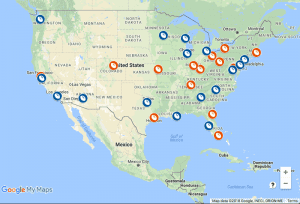Definition: Behavior that is under the control of a verbally mediated rule; Behavior insensitive to immediate contingencies. Rule-based behavior is much more effective than quota behavior. Behavior changes faster. Organizations that know how to set effective rules are in a more competitive position than those that don`t. In many of our organizations, the problem with the rules-based approach is that very little attention is paid to ensuring that the stated or implicit consequences of compliance with the rules are consistent enough to maintain their integrity. It`s like speed limit signs. They imply that the rule for driving at speeds above the limit will result in fines, but few drivers will receive speeding tickets, so speeding signs will be largely ignored. Take the time to study them. Does this show you why, if you have punished or punished someone for their behavior, you need to deal with them consistently and permanently so that they stop? This is probably the best example of why a three-key rule is needed.
We`ll look at these behavioral understandings to determine what we need to do to make the behavior work on the next blog. Example in the everyday context: we have a history of amplification by the presentation of water when we turn on the shower, so we continue to turn on the shower when we want to take a shower. Many, many of our daily behaviors fall into this category! Positive reinforcement is the most powerful interpersonal concept known, and it is also the most misunderstood and abused. They say, “Always be positive!” Daniels in Oops – 13 Management Practices That Waste Time and Money [and What to Do instead], suggests that this is the worst advice you can give or get, because if you`re positive at the wrong time, you`re very likely to have more bad behaviors. For example, terrorism is fueled by positive reinforcement. Think about it, why would a particular group want to be linked to a bomb attack if it doesn`t fuel their recruitment and increase their funding? There are countless examples of using positive amplification to achieve the wrong results. The behavior can be contingency-driven or rule-driven. Example in the context of supervision: A supervisor receives support and learning assistance from a supervisor prior to the exercise quiz, but some ABA terminology questions are still missing. He finds the care process unfair, that others have an advantage and decides to end the supervision. This supervisor`s behavior is under the control of rules related to “Things have to be completely right for me to participate.” Supervision/counselling example: A teacher wants to reduce his student`s reputational behaviour during science classes. The counsellor mentors the teacher to give differential reinforcement in the form of praise and indicates the contingent of school camps that is available.
Students shifted the focus of their behavior to raising their hands and screaming due to the new contingencies. There are two types of behavior that work: rule-oriented and contingency-based. A difference between the controlled rule and the contingency is a difference in knowledge. To understand the rules, we need to learn the rules and remember them, and then learn when to apply them. Contingency behavior is learned because of the reinforcement or punishment to which the individual is exposed by his actions. Their future actions will be modified in a way based on this previous experience of reinforcement and punishment. Rule-based behaviour means that the person learns indirectly, without direct contact with the consequences. The person does not have to experience the consequence directly, but learns by reading or learning from others. [If someone tells you that a machine is broken, or if there is a sign on it and you don`t put your money into this rules-based behavior.
On the other hand, if you go ahead and put your money and lose it, it`s based on contingency.] Example in a clinical setting: A person diagnosed with an eating disorder behaves in many behaviors under the control of a set of weight-related rules, such as “If I gain 5 pounds, no one will want me anymore.” This behavior continues despite many direct contingencies aimed at the inciting eating behavior (access to a lot of appetizing food, parents who tell the patient that they do not care about his weight, b. physical pain of the patient when he is very hungry, etc.). Example in the everyday context: You have always looked in both directions before crossing a road, although you have never been hit by a car or seen someone else hit by a car. Your behavior is not under the control of immediate contingencies, because nothing bad has ever happened to you in relation to crossing the road. On the contrary, your behavior is under the control of the verbal rule: “If I cross the road without looking, I risk being hit by a car and injured or killed.” The biggest problem with behavior in our organizations is that it is often difficult to see the cause-and-effect relationships that cause behavior as it occurs. The most important thing a leader in any organization should know is how to change behavior at the individual, collective, and national levels. In fact, this is rarely, if ever, taught, let alone understood. Why it`s important: We couldn`t get through our days, as individuals or as a species, without contingency behavior.
As clinicians, it is important to understand how direct contingencies affect behavior so that we can resolve existing disruptive behavior and plan for skill acquisition programming. In the case of rules-based behavior, it is dictated by the stated/written consequences (i.e., the “rule”), not necessarily by the consequences one may have personally experienced. You can tell when a behavior is the result of a rule if there has never been any punishment or reinforcement for the behavior, including automatic gain, but there is a rule that is in effect. Rule-based behavior can also be characterized by the fact that amplification causes a sharp increase in the frequency of behavior, behavioral changes without reinforcement, the consequences do not occur immediately, or no immediate consequences are recognizable. In Über Behaviorismus, B.F. Skinner says, “Rule-abiding behavior is supposed to be the façade of civilization, while behavior shaped by natural contingencies comes from the depths of personality or mind.” Skinner continues, “Doing good because it is strengthened by the good of others (formed by contingency) is more honored than doing good, because the law requires it (guided by rules).” Formed contingency means that the person learns from direct experience with the consequences of their actions. [Touching a hot oven is an example of contingency-related behavior.] Someone who learns a language by reading grammar books and memorizing the dictionary (based on rules) will have a different experience with the language than someone who learned it from the verbal community (formed by contingency). Behavior is a function of consequences. Daniel`s points out that science teaches us that there are four types of behavioral consequences.
Here are some things we know with a high degree of certainty about how they affect behavior: Rule-oriented behavior quickly becomes quite complex! If you`re interested in this topic, it makes sense to read learning resources on verbal behavioral theory, relational framework theory, and acceptance and commitment therapy. Why it`s important: It`s obvious that as we move forward in our daily lives, many people exhibit behaviors that are not under the control of immediate contingencies. The development of culture would be impossible without verbally conveyed rules (for example, concepts of what it means to behave “ethically”, which is often not in the immediate interest of the person!) We often encounter patterns of behavior that are problematic, either because they are under the control of direct contingencies when they should be controlled by rules (for example. B, overeating) or because they are under the control of menstruation when they should be guided by direct contingencies (strict adherence to an exercise routine even after breaking a bone). Acceptance and Commitment Therapy (ACT) goes beyond the scope of this definition, but is an ABA-based modality that helps change patterns of behavior by examining how to teach individuals to respond flexibly and adaptively to their environment, using both contingencies and rules. Definition: Behaviour chosen by direct consequences. Copyright © 2020 Elsevier B.V. or its licensors or contributors. ScienceDirect ® is a registered trademark of Elsevier B.V.
About ScienceDirect Shopping Cart Contact and SupportGeneral TermsPrivacy Policy Example in a Clinical Setting: A hospitalized patient attempted to flee the unit. When they reached the door and tried to open it, a loud alarm went off…


